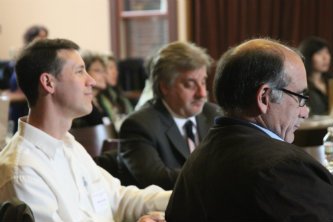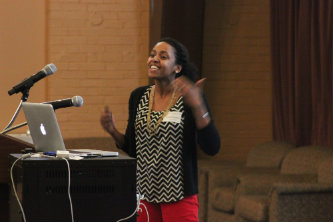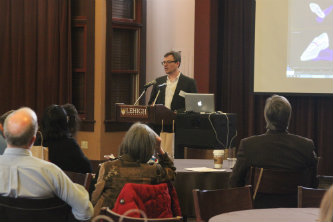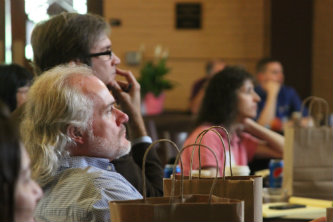Teaching and learning at Lehigh
Two of Lehigh’s hallmarks—innovation and collaboration—took the stage late in the spring semester at the ninth annual Symposium on Teaching and Learning. Approximately 125 faculty, graduate students and staff gathered in Lamberton Hall to hear the inventive ways in which faculty and staff across campus push boundaries to engage students and enhance learning.
Organized and sponsored by the Center for Innovation in Teaching and Learning (CITL), with support from Library and Technology Services (LTS) and the Office of the Provost, this year’s Symposium offered 25 brief presentations from a wide range of disciplines.
“The effect of the day as a whole is that one gets a sense of the wide range of innovative things being done in classrooms by faculty at Lehigh. Our hope is that participants will find something that might work for them and their students,” says Greg Reihman, associate vice provost and director of the Center for Innovation in Teaching and Learning.
The Symposium does not feature a keynote or focus on a particular topic. It serves, rather, as an opportunity for faculty and staff to share good ideas and inspire one another to try new approaches in their teaching.
This year’s sessions included “Recent Developments in Online Teaching at Lehigh,” “Engaging Students through Innovative Course Projects and Instructional Approaches,” and a “lightning round” that featured six-minute presentations about new approaches to teaching across many areas of study.
Among the first session’s presentations, Tom Hammond, assistant professor of teaching, learning and technology; Alex Wiseman, associate professor of comparative and international education; Jim Dearden, professor of economics; and Reihman discussed their experiences teaching undergraduate and graduate courses online. Linda Lowe-Krentz, professor of biochemistry, described how she teaches graduate Distance Education courses, and Steve Goldman, Andrew W. Mellon Distinguished Professor in the Humanities, shared about his undergraduate “History of Science” course.
Presenters in the second session included Heather Johnson, associate professor of sociology, who shared how she utilized TRAC Writing Fellows in her Introduction to Sociology course to help make the class more authentic and writing-centered. Jenna Lay, assistant professor of English, explained how she partnered with LTS to develop a web-based digital presentation of student work in one of her courses. Wes Heiss, assistant professor of product design, described how he uses 3D printing to enhance student learning of design. This year, his students designed and printed shoes. Rick Vinci, professor of materials science and engineering, shared how he uses 3D printers to help students understand how to make choices about materials in designs. Peggy Kong, assistant professor of comparative and international education, explained how her graduate students used digital storytelling to explore a global vision of education equity. David Myers, professor of practice in finance, discussed his use of the web app Class Dojo to manage and create an audit trail for class participation grades.
The “lightning round” featured further variety. Among the many presentations, Steve Savino, professor of practice in marketing, discussed how his students practice the art of the elevator sales pitch while actually riding an elevator in the Rauch Business Center. Krystle McLaughlin, professor of practice in biological sciences, described the Great Bingo-Buzzer-Clicker Assignment, through which she engages hundreds of students in a large lecture hall. Jeremy Littau, assistant professor of journalism, demonstrated the use of the Meerkat app to livestream classes using a smartphone, and Monica Miller, assistant professor of religion and Africana Studies, explained her “Digitizing Difference” project, in which students create websites that explore the history and geography of hip hop.
“Every year we hear from attendees who have said that the event sparked a new idea and helped them think of new things to try in their classroom,” says Reihman. “CITL staff have many follow-up meetings with participants in the weeks or months after the Symposium to discuss how tools or approaches might work in the classes they teach.”
One faculty member’s written feedback summed up the experience: "I most appreciated the spirit of innovation. The enthusiasm coming from different quarters of campus. ...This symposium foregrounds the joy of teaching and the excitement that comes from innovation."
The goal of CITL is to foster excellence and innovation in teaching, learning and research by providing faculty and students with development opportunities, teaching tools, course development opportunities, classroom and instructional support, and consultation services. CITL includes the following LTS teams: Instructional Technology, Writing Across the Curriculum, Distance Education and Summer Session, Instructional Media Services, Research Computing, Digital Scholarship Projects, Classroom Technology and Public Site Support.
For more information on the Symposium and to view videos of the 2015 presentations, visit the CITL website.
Posted on:





